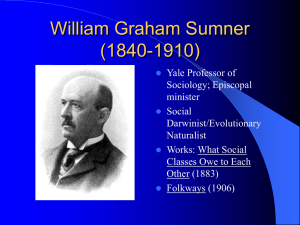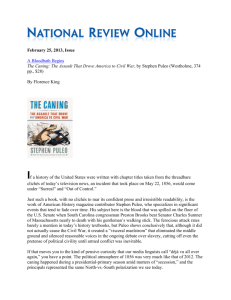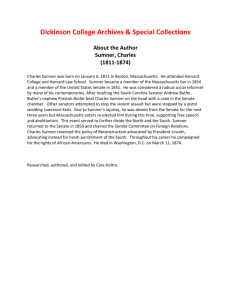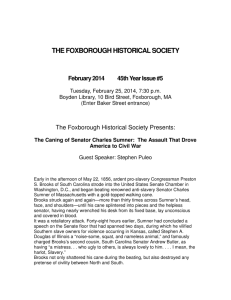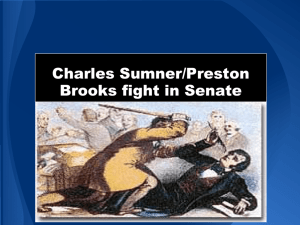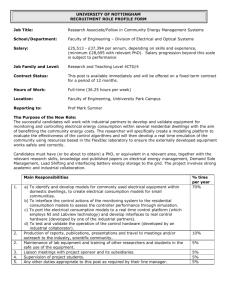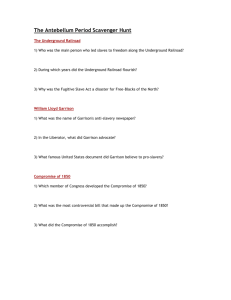Williamjames Hull Hoffer
advertisement
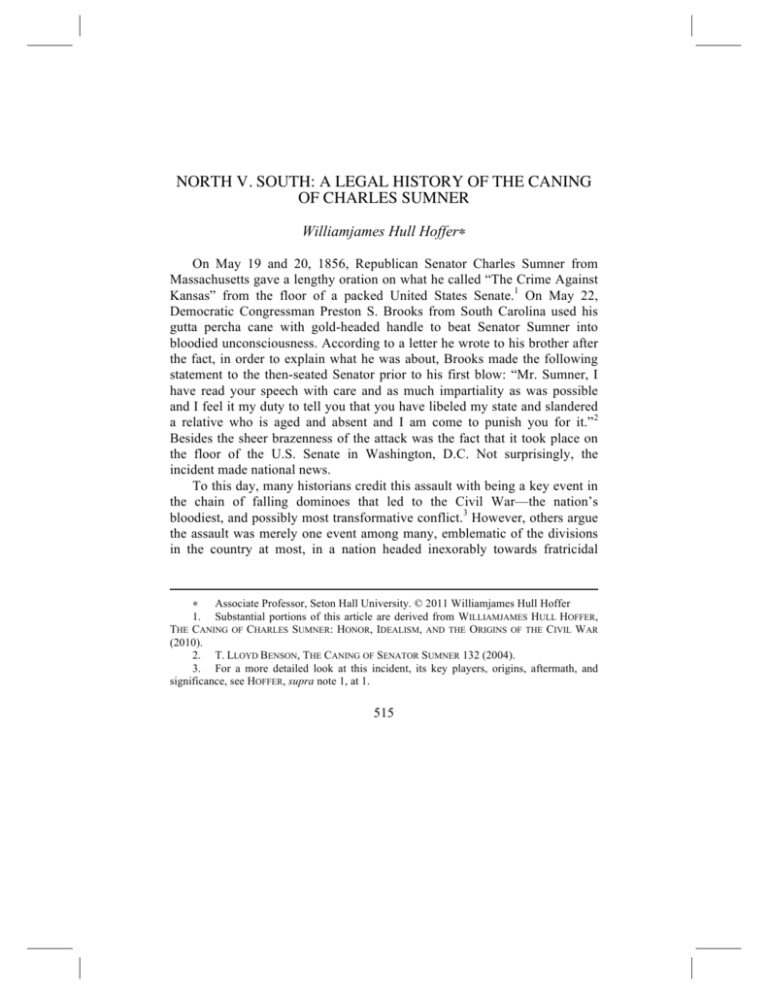
NORTH V. SOUTH: A LEGAL HISTORY OF THE CANING OF CHARLES SUMNER Williamjames Hull Hoffer∗ On May 19 and 20, 1856, Republican Senator Charles Sumner from Massachusetts gave a lengthy oration on what he called “The Crime Against Kansas” from the floor of a packed United States Senate.1 On May 22, Democratic Congressman Preston S. Brooks from South Carolina used his gutta percha cane with gold-headed handle to beat Senator Sumner into bloodied unconsciousness. According to a letter he wrote to his brother after the fact, in order to explain what he was about, Brooks made the following statement to the then-seated Senator prior to his first blow: “Mr. Sumner, I have read your speech with care and as much impartiality as was possible and I feel it my duty to tell you that you have libeled my state and slandered a relative who is aged and absent and I am come to punish you for it.”2 Besides the sheer brazenness of the attack was the fact that it took place on the floor of the U.S. Senate in Washington, D.C. Not surprisingly, the incident made national news. To this day, many historians credit this assault with being a key event in the chain of falling dominoes that led to the Civil War—the nation’s bloodiest, and possibly most transformative conflict.3 However, others argue the assault was merely one event among many, emblematic of the divisions in the country at most, in a nation headed inexorably towards fratricidal ∗ Associate Professor, Seton Hall University. © 2011 Williamjames Hull Hoffer 1. Substantial portions of this article are derived from WILLIAMJAMES HULL HOFFER, THE CANING OF CHARLES SUMNER: HONOR, IDEALISM, AND THE ORIGINS OF THE CIVIL WAR (2010). 2. T. LLOYD BENSON, THE CANING OF SENATOR SUMNER 132 (2004). 3. For a more detailed look at this incident, its key players, origins, aftermath, and significance, see HOFFER, supra note 1, at 1. 515 516 RUTGERS LAW JOURNAL [Vol. 43:515 conflict.4 What we might miss among the colorful characters, dramatic twists and turns, and the sharp contrast between Brooks’ adherence to the honor culture and Sumner’s brash abolitionism is that the caning of Charles Sumner was as much a legal clash—a deeply Constitutional one at that—as it was a culture clash.5 As Alexis de Tocqueville wrote about America in the 1820s and 1830s, “Scarcely any political question arises in the United States which is not resolved, sooner or later, into a judicial question.”6 The time has come to understand the caning as part of the constitutional context that brought about the Civil War that started one hundred and fifty years ago. This article explores this incident as a matter of law in three different respects. First, there is the division between Sumner and Brooks, North and South, abolitionist and states’ rights defender of slavery on constitutional grounds. Second, there is the clash between these two lawyers about the nature of law itself. Third, the caning itself presented legal issues about honor, congressional privilege, federal criminal law, and the workings of an adversarial legal system in a time of fractious legal culture. This panoply of issues will help us understand a little better not only the workings of American law in the years leading up to the Civil War, but also how that very system helped bring about that momentous conflict. Debate in Congress over the expansion of slavery into the territories had a long and often verbally violent career. Overstatement, threats of secession, and predictions of bloodshed marked the controversy over Missouri’s application for statehood in 1819. Missouri was then part of the Louisiana Territory acquired by purchase from France in 1803 and under the provisions of the Northwest Territory Act of 1787, its provisional legislature could write a republican constitution and petition for statehood when the population had reached 60,000. By 1819, much of that population had come from the neighboring southern states, and many of those migrants had brought their slaves with them (some 10,000 slaves by 1820). But when the petition for statehood, with an accompanying draft constitution, arrived at Congress, it did not bar slavery. New York Republican congressman James Tallmadge introduced a motion to provide for gradual emancipation of Missouri’s slaves, and the floodgates of sectional vituperation opened. A series of compromises brokered in the Senate by Kentucky’s Henry Clay ended the crisis. Missouri entered the Union as a slave state and Maine, hitherto a 4. 1991). 5. 6. 1984). See THE CAUSES OF THE CIVIL WAR, REVISED EDITION (Kenneth M. Stampp ed., For a summary of the literature on these topics see BENSON, supra note 2, at 1. ALEXIS DE TOCQUEVILLE, DEMOCRACY IN AMERICA 126 (Richard D. Heffner ed., 2013] THE CANING OF CHARLES SUMNER 517 province of Massachusetts, entered as a free state. More important, the rest of the Louisiana Territory was divided into future free and slave states at 36-30’ latitude—a line of demarcation that would become a part of the controversy over the admission of Kansas.7 The proximate cause, if you will, of the confrontation between our two lawmakers and lawyers was this debate over the events in the Kansas territory, abetted in Sumner’s mind by the Kansas-Nebraska Act of 1854, which gave the people of Kansas the authority to determine whether or not their future would lie in a free state or a slave state. For the act’s supporters, like its key sponsor in the Senate, Stephen A. Douglas of Illinois, the question was one of “popular sovereignty.” This notion held that the people of a territory had the right to self-determination. Closely linked to the Democratic Party’s founding principles of states’ rights and individual liberty, this set of ideas comprised more than just a party slogan. It was in the DNA of the democracy, as the party liked to be known, stemming from the leadership of the party at the time it was formed: Andrew Jackson and Martin Van Buren. Theirs was not just a congeries of policies and political preferences. It was a constitutional philosophy that claimed sole legitimacy in the face of the Federalist Party and its ideological successors in the short lived National Republican party that supported John Quincy Adams to succeed James Monroe as president in 1824.8 But the Kansas Nebraska Act of 1854,9 passed after great acrimony, repealed the Missouri Compromise line of 36-30, for under it Kansas lay north of the line and should have entered the Union as a free state. In fact, no sooner had the Act passed, than pro-slave migrants from Missouri poured 7. See MICHAEL HOLT, THE FATE OF THEIR COUNTRY: POLITICIANS, SLAVERY EXTENSION, AND THE COMING OF THE CIVIL WAR (2004). For the seminal books on the 1850s, see AVERY CRAVEN, THE COMING OF THE CIVIL WAR (1957); DAVID M. POTTER, THE IMPENDING CRISIS, 1848-1861 (1976); 1 WILLIAM W. FREEHLING, THE ROAD TO DISUNION: SECESSIONISTS AT BAY, 1776-1854 (1990), 2 THE ROAD TO DISUNION: SECESSIONISTS TRIUMPHANT, 1854-1861 (2007); MICHAEL F. HOLT, THE POLITICAL CRISIS OF THE 1850s (1978); BRUCE LEVINE, HALF SLAVE AND HALF FREE: THE ROOTS OF THE CIVIL WAR (1992); WHY THE CIVIL WAR CAME (Gabor S. Boritt ed., 1996); EDWARD L. AYERS, WHAT CAUSED THE CIVIL WAR? REFLECTIONS ON THE SOUTH AND SOUTHERN HISTORY (2005); KENNETH M. STAMPP, THE IMPERILED UNION: ESSAYS ON THE BACKGROUND OF THE CIVIL WAR (1980); MARK W. SUMMERS, THE PLUNDERING GENERATION: CORRUPTION AND THE CRISIS OF THE UNION, 1849-1861 (1987); Jean Harvey Baker, Politics, Paradigms, and Public Culture, 84 J. AM. HIST. 894, 894–99, (1997); JONATHAN H. EARLE, JACKSONIAN ANTISLAVERY & THE POLITICS OF FREE SOIL, 1824-1854 (2004). 8. See generally GERALD LEONARD, THE INVENTION OF PARTY POLITICS: FEDERALISM, POPULAR SOVEREIGNTY, AND CONSTITUTIONAL DEVELOPMENT IN JACKSONIAN ILLINOIS (2002). 9. Kansas Nebraska Act of 1854, 10 Stat. 277 (1854). 518 RUTGERS LAW JOURNAL [Vol. 43:515 into the Territory with the intent of occupying it for the slave power. Led by David Atchison, the pro-slavery forces were determined to carry slavery to the Pacific. They had blustered and threatened secession when California entered the Union as a free state, but much territory lay north of California, and had it been organized as slave states, slavery would have had the permanent protection of a friendly U.S. Senate.10 To what extent the controversy between pro-slavery and so-called free soil advocates was really about slavery or in the alternative about states’ rights, was never clear. Certainly politics was involved, as the anti-slavery coalition of free soil Democrats, “Conscience Whigs” Liberty Party men, and abolitionists were forming the new Republican Party (not to be confused with Jefferson’s Republicans, whose direct descendent was the Democratic Party) around the issue of free soil. But many of the Stalwarts of that new party were abolitionists rather than mere free soil advocates. It was these men whom the defenders of the South and the “peculiar institution” of slavery saw as the real danger to southern interests and honor. Despite these fractious debates, in some respects Charles Sumner and Preston S. Brooks were alike. They were both well educated at the foremost school in their respective states: Harvard and the future University of South Carolina. They came from distinguished if not elite families. Although Sumner was eight years older, their generations were not entirely different. They came from old stock families that could trace their roots to the founding of their respective colonies. Finally, they were both admitted to the bar and practiced law for a time before settling into their careers in politics. But, there were important differences and these differences stemmed from the distinct histories of their home states. Preston S. Brooks was a product and defender of both the South as a region and slavery as an institution. Brooks’ family lived in the upcountry, in the ninety-sixth electoral district of Edgefield County known as “Old 96”. “Fighting Edgefield” became the center point for South Carolina politics as the population shifted to the interior. At the same time, more so than any other area in South Carolina, perhaps the entire South, this district gained a reputation for interpersonal violence. While in slavery itself violence hovered everywhere, the degree of violence among the ruling class was untoward. In a moral pamphlet about a wife who had killed three of her husbands he wrote while there as a minister, The Devil in Petticoats, Parson Mason L. Weems of 10. For a specific study on how “Bleeding Kansas” entered into the national political debate, see CRAIG MINER, SEEDING CIVIL WAR: KANSAS IN THE NATIONAL NEWS, 1854-1858 (2008). 2013] THE CANING OF CHARLES SUMNER 519 George Washington biography fame, remarked: “Oh mercy! . . . Another murder in Edgefield. For sure it must be pandemonium itself, a very district of Devils!”11 Preston Brooks was born in Edgefield on August 5, 1819, in a substantial mansion surrounded by four acres of flower gardens. He was the second son of planter, lawyer, and politician Whitfield Brooks and Mary Carroll Brooks. His family connections crisscrossed the state, but with this prestige came the perils of a closely related, factional community. Young Preston did well in school and was intelligent, good-looking, and good natured according to most accounts. After schooling at home, then Moses Waddel’s School at Willington, he attended South Carolina College, later re-named the University of South Carolina, in the state capital, Columbia. There he demonstrated the strong personality that colored his adult life. While a superb student, he was frequently absent.12 The taverns and social opportunities were too much of a temptation for this six foot braggadocio. Altercations were frequent enough to gain notice. Three episodes are worthy of description. After a disputed college election, he fought with a fellow student. Because he had refused to duel his opponent, he received only a temporary suspension while the other student was expelled. One might say that college boys, being privileged and recognized as gentlemen often took to the field of honor. The second incident happened shortly before his expected graduation when Brooks heard his brother had been arrested and jailed. With two pistols he broke into the jailhouse and demanded his brother’s release. Disarmed without further incident, no charges were brought, but the College had had enough of his antics and withheld his degree. 11. MASON LOCKE WEEMS, THE DEVIL IN PETTICOATS, OR, GOD'S REVENGE AGAINST HUSBAND KILLING 3 (1857). For information on Edgefield in particular, see JACK KENNY WILLIAMS, VOGUES IN VILLAINY: CRIME AND RETRIBUTION IN ANTE-BELLUM SOUTH CAROLINA (1959); JACK KENNY, DUELING IN THE OLD SOUTH: VIGNETTES OF SOCIAL HISTORY (1980); ORVILLE VERNON BURTON, IN MY FATHER’S HOUSE ARE MANY MANSIONS: FAMILY AND COMMUNITY IN EDGEFIELD, SOUTH CAROLINA (1985). 12. For Brooks’ biography see Robert Neil Mathis, Preston Smith Brooks: The Man and His Image, SOUTH CAROLINA HISTORICAL AND GENEALOGICAL MAGAZINE, October 1978, at 79; STEPHEN W. BERRY II, ALL THAT MAKES A MAN 296–311 (2002); J. Holt Merchant, Laurence M. Keitt: South Carolina Fire-Eater (1976) (unpublished Ph.D. dissertation, Univ. of Virginia); Eric Harry Walther, The Fire-Eaters, the South, and Secession (1988) (unpublished Ph.D. dissertation, La. State Univ.); ALVY L. KING & LOUIS T. WIGFALL: SOUTHERN FIREEATER (1970); and C. W. Lord, Young Louis Wigfall: South Carolina Politician and Duelist, SOUTH CAROLINA HISTORICAL AND GENEALOGICAL MAGAZINE, April 1958, at 59. 520 RUTGERS LAW JOURNAL [Vol. 43:515 A more serious encounter developed in 1840 when Louis T. Wigfall, a prominent rival of the Brooks family in Edgefield County politics, “posted” Whitfield Brooks for refusing to duel him. Posting was the last resort of an honor dispute with a recalcitrant opponent under the Code Duello. One put a sign in a public place denouncing the man in no uncertain terms. Per tradition, Wigfall also chose to defend the sign against removal. To be posted was one of the worst forms of shaming. Whitfield Brooks’ brother-in-law, James Parsons Carroll, and another relative, Thomas Butler Bird, confronted Wigfall. In the pistol fight that ensued Bird died and Carroll challenged Wigfall to a duel. They met on Goat Island in the Savannah River to avoid falling under a legal jurisdiction that banned dueling. After an exchange of shots, their seconds convinced them honor had been satisfied. But this was not satisfying to Brooks, who renewed the challenge. When their initial misses proved insufficient, Wigfall was shot through the thighs and Brooks in the hip in the second exchange. Both took time to recover, but Brooks emerged the victor, at least in public opinion. Negotiations over the various parties’ newspaper publications continued after their respective recoveries. Eventually, a year after the original dispute had begun, both agreed to retractions of previous statements, and their seconds were credited with averting further violence. We should observe that despite the fact that dueling was illegal no one would have thought to prosecute them for their behavior. In this community, there was a distinction between the letter of the law and actual sanctioned behavior. In cases of honor, social approbation sometimes came from setting aside the law books. South Carolina, like other slave states, passed anti-dueling laws, setting heavy fines for participation and ruling that in the case of a fatality, the charge was homicide. But seldom if ever were these penalties imposed. Legislatures would repeal anti-dueling laws but juries would never convict. The custom was too popular even though it meant that the upper caste of society was given the privilege of “natural liberty” that is the right to challenge and fight under rules of the code duello, whereas ordinary citizens had to face the majesty of law.13 But Brooks did not act wholly according to his personal whim. Culture has a stickiness, an enveloping power that no one can entirely shed. Brooks 13. South Carolina’s trajectory towards secession can be found in WALTER EDGAR, SOUTH CAROLINA: A HISTORY (1998); Lacy K. Ford, ORIGINS OF SOUTHERN RADICALISM: THE SOUTH CAROLINA UPCOUNTRY, 1800-1860 (1988); RACHEL N. KLEIN, UNIFICATION OF A SLAVE STATE: THE RISE OF THE PLANTER CLASS IN THE SOUTH CAROLINA BACKCOUNTRY, 1760-1808 (1990); HAROLD S. SCHULTZ, NATIONALISM AND SECTIONALISM IN S.C., 1852-1860 (1969); MANISHA SINHA, THE COUNTERREVOLUTION OF SLAVERY (2000). 2013] THE CANING OF CHARLES SUMNER 521 wanted to be regarded by all in his community and state as a gentleman, wanted his father’s and his older brother’s and his neighbor’s admiration, and to have acted otherwise in the Wigfall affair would have been to court shame. That state of existence carried far greater meaning than it does today. To be shamed meant to be considered an outcast of society, including one’s own family perhaps, and be forced to leave the region. Such a separation doomed the miscreant possibly to penury because he had no friends or family members to advance his fortune. In a society of low productivity and a limited number of professional positions of significance that was a genuine hardship. It was this combination of personality and culture that almost dictated Brooks’ actions. By submitting himself to the code he showed his mettle as a man.14 Brooks was less fortunate when it came time to prove his mettle in battle. He captained the all-volunteer Palmetto regiment in the Mexican War, but had to leave for home when he developed debilitating typhus upon his entry on Mexican soil. He went home. In agony over his long recovery, seeing in his neighbors’ faced disparaging looks, he managed to arrange for a regular army commission and sped to the front. Once there, he received a double blow: the death of his much beloved older brother and the end of formal hostilities. With all of the fanfare of having served and none of the manful risks of combat, he returned home. He felt great shame in this set of circumstances. It is no accident that the honor culture also prevailed in other societies that shared the slaveholding South’s circumstances. With its aristocrats, large peasant population, and cultivated sense of superiority, France popularized its honor code through the presence of its officers among the revolutionaries in America’s war for independence. Russia lost perhaps its greatest man of 14. For detailed descriptions and analyses of the honor culture in the South see Edward Pessen, How Different from Each Other Were the Antebellum North and South, THE AM. HIST. REV. Dec. 1980, at 1119.; Michael Stephen Hindus, PRISON AND PLANTATION: CRIME, JUSTICE, AND AUTHORITY IN MASSACHUSETTS AND SOUTH CAROLINA, 1767-1878 (1980); BERTRAM WYATT-BROWN, YANKEE SAINTS AND SOUTHERN SINNERS (1985); HONOR AND VIOLENCE IN THE OLD SOUTH (1986); BERTRAM WYATT-BROWN, THE SHAPING OF SOUTHERN CULTURE: HONOR, GRACE, AND WAR, 1760s-1880s (2001); BERTRAM WYATT-BROWN, SOUTHERN HONOR: ETHICS AND BEHAVIOR IN THE OLD SOUTH (2007); EDWARD L. AYERS, VENGEANCE AND JUSTICE: CRIME AND PUNISHMENT IN THE 19th-CENTURY AMERICAN SOUTH (1984); KENNETH GREENBERG, HONOR & SLAVERY (1996); KENNETH S. GREENBERG, MASTERS AND STATESMEN: THE POLITICAL CULTURE OF AMERICAN SLAVERY (1988); DICKSON D. BRUCE, JR., VIOLENCE AND CULTURE IN THE ANTEBELLUM SOUTH (1979); Elliott J. Gorn, Gouge and Bite, Pull Hair and Scratch: The Social Significance of Fighting in the Southern Backcountry, THE AM. HIST. REV. Feb. 1985, at 18. 522 RUTGERS LAW JOURNAL [Vol. 43:515 letters, Alexander Pushkin, in a duel. Germany was rife with young men who bore the scars of its form of duels with short sabers or had died from a thrust from a short sword. Duels were the natural outgrowth of the honor culture and the honor culture a natural outgrowth of an aristocratic society built on the oppression of a servile class.15 In many respects, this was a transatlantic cultural phenomenon, an outgrowth of the Romantic Movement. Besides reading Johann Wolfgang von Goethe’s The Sorrows of Young Werther, gentlemen in all of these societies read the novels of authors like Sir Walter Scott, which emphasized the knightly virtues of bygone eras. We also cannot discount the impact of religion, in particular Protestantism’s emphasis on a sinful world and the inevitable temptations of man’s passionate nature. An aside, oddly Scott was a great opponent of dueling and the ethic of honor itself even though he romanticized the heroics of violent men. Despite the fact that South Carolina had outlawed the practice, as Brooks’ own history shows, features of the honor culture like dueling remained a part of South Carolinian life. Linked to one’s public reputation, honor was more than just manliness, character, and position in society. It undergirds everything that made you who you were from your creditworthiness—a critical item in an economy built on debt—to your social life. Men like Andrew Jackson and Sam Houston had to flee their homes in South Carolina and Tennessee, respectively, when their honor was impinged. For Jackson it was business failures and allegations about his beloved wife; for Houston it was a mystery relating to his new wife. Because of its centrality to life in the South, and South Carolina especially, we cannot discount the honor culture’s effect on every southern gentleman’s world view including that of Preston S. Brooks.16 15. There is no better source other than the works of Bertram Wyatt Brown than JOANNE B. FREEMAN, AFFAIRS OF HONOR: NATIONAL POLITICS IN THE NEW REPUBLIC (2001) for discussion of the honor culture and its widespread influence. 16. For the South’s relationship with slavery and its effects on their politics, see JOHN HOPE FRANKLIN, THE MILITANT SOUTH, 1800-1861 (2002); AVERY O. CRAVEN, THE GROWTH OF SOUTHERN NATIONALISM, 1848-1861, A HISTORY OF THE SOUTH (Wendell Holmes Stephenson & E. Merton Coulter eds., 1953); JAMES C. COBB, AWAY DOWN SOUTH: A HISTORY OF SOUTHERN IDENTITY (2005); STANLEY M. ELKINS, SLAVERY: A PROBLEM IN AMERICAN INSTITUTIONAL AND INTELLECTUAL LIFE (3d ed., 1976); ROBERT WILLIAM FOGEL & STANLEY L. ENGERMAN, TIME ON THE CROSS: THE ECONOMICS OF AMERICAN NEGRO SLAVERY (1974); SALLY E. HADDEN, SLAVE PATROLS: LAW AND VIOLENCE IN VIRGINIA AND THE CAROLINAS (2001); CHRISTINE LEIGH HEYRMAN, SOUTHERN CROSS: THE BEGINNINGS OF THE BIBLE BELT (1997); THOMAS D. MORRIS, SOUTHERN SLAVERY AND THE LAW, 1619-1860 2013] THE CANING OF CHARLES SUMNER 523 Brooks, unlike Sumner, had a well-established family life. Though his first wife died soon after the birth of their only child, he followed tradition and married her younger sister with whom he had two more children. With the brief interruption of the Mexican-American War, he practiced law, managed a small plantation, and embarked upon a career in politics. By 1852, when he ran for Congress in the fourth district, national politics had turned sour for defenders of the slaveholding south. England had ended slavery in its empire, and so had the French. The Royal Navy patrolled the African coast, intercepting slave traders. Latin American countries with the exception of Brazil had renounced slavery, though it still existed in portions of their old empire that the Spanish retained. More worrisome, at home abolitionists had redoubled their efforts, shifting from the effort to persuade slaveholders to free their slaves and provide for their passage to Africa to immediate emancipation in the states. The land gained from the Mexican War was not opened to slavery. The inability to expand the realm of slavery was felt keenly in South Carolina. With no outlet for its black majority, many of the state’s political leaders had developed a combative stance toward the slavery question. While a few moderates like Chief Justice John Belton O’Neal urged confidence in the law and the union, others became “fire-eaters” and demanded that some accommodation be made to South Carolina’s needs or else. Whatever one’s political stance in the state, it had taken on a Sparta-like quality by the early 1850s. All of its free white males were to serve in the militia. Every man capable of bearing arms would have to gain a working knowledge of military affairs. When a master class is sitting on the powder keg of an enslaved African-American majority, they might well choose the Spartan solution to their enslaved helots: a commitment to the ways of soldiering and slave patrols. This particular version of the social contract wedded the contradictory principles of limited government and the maintenance of a massive authority over the slaves. In the English speaking world, the social contract took the form of laws that defined citizenship, and the place of the citizen in this society. Though Brooks gained admission to the bar and practiced briefly for a time, the same as Sumner, his role as an attorney in South Carolina was significantly different than it would have been in Massachusetts because of slavery. For example, Brooks had no opportunity to participate in a venture like prison reform because there were no state penitentiaries in South (1996); KENNETH M. STAMPP, THE PECULIAR INSTITUTION: SLAVERY SOUTH (1956). IN THE ANTE-BELLUM 524 RUTGERS LAW JOURNAL [Vol. 43:515 Carolina and penal code reform became associated with abolitionism. For antebellum South Carolina the very concept of state-run penitentiaries for perpetual imprisonment was inimical. The prototypical criminal was the slave, devious in character, primitive in intellect, and prone to all the evils of a supposedly barbaric race under the philosophy that created race-based slavery. The slave system kept the animal nature of blacks in check.17 Feeding into this siege mentality was South Carolina’s unique experience in the Nullification Crisis from 1828 to 1833. South Carolina had suffered enormously economically during the 1820s. Though it is likely poor state planning, the financial collapse of 1819, and the rapidly depleted soils of the northwest from cotton cultivation were the cause, an influential majority held the tariff—taxes on imports—the United States government passed in the 1820s, particularly the so-called Tariff of Abominations in 1828, responsible. Under the philosophical and legal reasoning of John C. Calhoun, Jackson’s increasingly estranged vice-president, the South Carolina’s legislature adopted the nullification doctrine as state policy in November of 1832, declaring that each state had a right under the U.S. Constitution to declare null and void federal legislation under certain conditions and that South Carolina was exercising that right regarding the tariff. As Andrew Jackson was preparing to send the U.S. Navy to Charleston harbor to enforce federal law and South Carolina’s governor prepared its militia, cooler heads in Washington worked out a compromise. The Congress repealed the sections of the tariff law South Carolina opposed and passed a Force Bill authorizing President Jackson to use the U.S. military against South Carolina. When it became clear that even the leaders of Georgia and Alabama opposed its stance on nullification, South Carolina repealed its secession ordinance on March 11, 1833. Its leaders took several lessons from this crisis. First, South Carolina should not be caught unprepared militarily. Establishment of a military academy, later called the Citadel, in 1842 provided a future officer corps. Second, South Carolina should not act alone in any dispute over federal government powers. Third, the rest of the country preferred negotiation to war. Though Preston Brooks seldom spoke in his two terms in the House prior to his caning of Sumner, he endorsed these notions when he did speak (even if his defense of measures like the Fugitive Slave Act of 1850 contradicted 17. See generally MICHAEL STEPHEN HINDUS, PRISON AND PLANTATION: CRIME, JUSTICE, SOUTH CAROLINA, 1767-1878 (1980); KENNETH AND AUTHORITY IN MASSACHUSETTS AND GREENBERG, HONOR AND SLAVERY (1996). 2013] THE CANING OF CHARLES SUMNER 525 them). In defending the Kansas-Nebraska bill on March 15, 1854, he summarized his constitutional philosophy as follows: It becomes us of the South to avail ourselves of the opportune occasion, to bring back congressional legislation within constitutional restraint—to reassert the great constitutional principle, that as the people are the source of all political power, they have, in the capacity of sovereign States, the inherent right of self-government, and to regain our constitutional right to go 18 with our property, of every description, upon any part of the public domain. He next provided a refutation of those whom he held to “love their brethren in black more than those of the same color as themselves.”19 Brooks then quoted from such notable delegates to the Constitutional Convention as Oliver Ellsworth, Roger Sherman, John Dickinson, Luther Martin, George Mason, Elbridge Gerry, John Langdon, Charles Pinckney, Hugh Williamson, Abraham Baldwin, and Gouverneur Morris to show the preference for leaving slavery alone. In the words of Morris, “these things form a bargain among the northern and southern States.”20 He either did not know or willfully omitted the fact that Martin, Mason, and Gerry did not sign the document. Brooks also objected to the view that somehow the national interest might differ from that of the local interest. “Sir, there is a suspicious sound in that word national, which jars upon southern ears, and when coupled with the doctrines it inculcates, comes athwart the gale like the low whistle of the bandit, and admonishes honest men to look well to the security of their estates.”21 Here, then, was a Jeffersonian view of the Constitution. It protected all property. It was a compact among the several states. It had limited powers. Anything that promoted a national spirit coming from the federal government provoked suspicion. Finally, it had a long, distinguished history with the support of many of the country’s leading political and legal lights.22 18. 19. 20. 21. 22. CONG. GLOBE, 33D CONG., 1ST SESS. 371 (1854) (statement of Rep. Preston Brooks). Id. Id. at 372. Id. For more on the ideology of the Democratic Party during the Civil War Era, see ALEXANDER SAXTON, THE RISE AND FALL OF THE WHITE REPUBLIC: CLASS POLITICS AND MASS CULTURE IN NINETEENTH CENTURY AMERICA (1990); HARRY L. WATSON, LIBERTY AND POWER: THE POLITICS OF JACKSONIAN AMERICA (1990). 526 RUTGERS LAW JOURNAL [Vol. 43:515 Standing in stark contrast to what we may call this Jeffersoniandemocratic view of the Constitution was the advocacy of abolitionists like Charles Sumner. It was not in complete opposition to the individualism and lower case “d” democracy that Democrats like Brooks espoused, but it differed in several important respects. Although Sumner gave several orations that contained his constitutional principles, an analysis of his constitutional arguments in his “Crime Against Kansas” speech is sufficient for our present purposes. However, they may only be properly illuminated in light of Sumner’s background. Sumner was as sincere and as committed in his opposition to slavery as Brooks was in its defense. Born in Boston on January 6, 1811, to a minister’s family, the future senator had a distinguished lineage, but soon faced straightened circumstances on the death of his father.23 Thanks to the assistance of family friends, the boy attended elite schools in Boston before embarking on his studies at Harvard, first as an undergraduate, then as a law student. With his law degree in hand, he apprenticed, and then embarked upon a legal career of some note, but not great financial success. Charles Sumner found the work of an attorney to be beneath his considerable sense of his own calling, his vocation. With his practiced orations, Sumner gained a considerable reputation as a speaker, but his devotion to his causes provoked as much consternation as it did praise. He made a considerable stir by pleading for pacifism and world peace on a day to commemorate the nation’s victory in the War of the American Revolution. His fierce commitment to abolitionism, equal rights for African-Americans, and moral purity brooked no compromise nor did he devote much energy to coalition building even for causes like prison reform that required a more sensitive touch. Thanks to his deft maneuvering and the impressive efforts of his allies, the Massachusetts legislature of Democrats, Conscience Whigs (those members of the Whig Party opposed to slavery), and the nativist, anti-immigrant American or Know Nothing Party selected him to be one of the Bay State’s U.S. Senators in 1850. While there, the isolated abolitionist made many friends, but few allies for his causes. His sole contribution had been his speeches. These mixtures of harsh words, fierce arguments, Constitutional renderings, and classical flourishes gave him a reputation far beyond any legislative accomplishments. 23. For a good, recent, short biography of Sumner, see FREDERICK J. BLUE, CHARLES SUMNER AND THE CONSCIENCE OF THE NORTH (1994). See also DAVID H. DONALD, CHARLES SUMNER AND THE COMING OF THE CIVIL WAR (1960); but see ANNE-MARIE TAYLOR, YOUNG CHARLES SUMNER AND THE LEGACY OF THE AMERICAN ENLIGHTENMENT, 1811-1851 (2001) (critiquing Donald’s portrait of Sumner). 2013] THE CANING OF CHARLES SUMNER 527 His “Crime Against Kansas” effort on May 19 and May 20 in 1856 was no exception. Sumner’s many hour oration was not a dry discourse on constitutional principles. Nor was it simply a political harangue. It contained language that Brooks likely considered offensive because Sumner had several ulterior purposes in mind. These purposes connected his personhood and his principles to the larger constitutional quarrel. As part of his description of Senator Andrew P. Butler from South Carolina—Brooks’ second cousin and the aged, infirm subject of his grievance—as the Don Quixote to Senator Douglas’ Sancho Panza, Sumner stated: The senator from South Carolina has read many books of chivalry, and believes himself a chivalrous knight with sentiments of honor and courage. Of course he has chosen a mistress to whom he has made his vows, and who, though ugly to others, is always lovely to him; though polluted in the sight of 24 the world, is chaste in his sight—I mean the harlot, slavery. He went on to describe the speech-impaired Butler later in the speech as follows: With regret, I come again upon the senator from South Carolina, [Mr. Butler] who, omnipresent in this debate, overflowed with rage at the simple suggestion that Kansas had applied for admission as a State; and, with incoherent phrases discharged the loose expectoration of his speech, now 25 upon her representative, and then upon her people. And, “He cannot open his mouth, but out there flies a blunder.”26 Last, and certainly not inconsiderable was the conclusion of Sumner’s comparison of the histories of Kansas and South Carolina: Were the whole history of South Carolina blotted out of existence, from its very beginning down to the day of the last election of the senator to his present seat on this floor, civilization might lose—I do not say how little, but surely less than it has already gained by the example of Kansas, in its valiant 24. T. LLOYD BENSON, THE CANING OF SENATOR SUMNER 99 (2004). 25. Id. at 117. 26. Id. 528 RUTGERS LAW JOURNAL [Vol. 43:515 struggle against oppression, and in the development of a new science of 27 emigration. These were extraordinarily harsh words, far outside of the bounds of decorum and propriety that usually governed speeches in the Senate. Why was Sumner so vituperative? The answer in part lies in the election cycle, for Sumner was running for re-election in 1856 and the nascent Republican Party was battling for supremacy in the North in this presidential election year; but, because he had little in the way of legislative accomplishments (not unsurprisingly given that his Republicans were a small minority in the Senate), he had only his orations to promote himself and his party. After all, thanks to the state-based electoral college, all the Republicans had to do was win the more populous northern states. More substantially, he actually gained in stature when he attracted even adverse publicity. The Senate floor became a microphone and his voice carried into the remotest part of the country. As he himself stated in the speech, “But the Slave Power dares anything, and it can be conquered only by the united masses of the People. From Congress to the people I appeal.”28 In his concluding remarks, he repeated the call. “To the People, now on the eve of exercising the electoral franchise, in choosing a Chief Magistrate of the Republic, I appeal, to vindicate the electoral franchise in Kansas. Let the ballot-box of the Union, with multitudinous might, protect the ballot-box in that Territory.”29 The Republican Party’s needs in the Constitution’s framework for party success, thus, provided an incentive, if not a spur, to exaggerate, stir up, and otherwise take advantage of disputes that might otherwise have subsided. But Sumner, if not entirely above politics, was also personally outraged by the idea that slavery could become national. Sumner willed himself to the center of this response. A voracious reader and a good friend of many of the Transcendentalists of Boston’s energetic intellectual community, Sumner was well aware of the writings of eminent New Englanders like Henry David Thoreau whose civil disobedience ideas would echo down to civil rights leaders like Mohandas K. Gandhi and Martin Luther King, Jr. It is likely that Sumner wanted a violent response that would expose, at least to his way of thinking and probably those of his constituents, the barbarity of the slave power. Douglas’s off the cuff response to the “Crime Against Kansas” 27. Id. at 118. 28. CHARLES SUMNER, THE ANTI-SLAVERY CRUSADE IN AMERICA 91 (Arno Press, 1969). 29. Id. at 94. 2013] THE CANING OF CHARLES SUMNER 529 speech was on the mark: “Is it his object to provoke some of us to kick him as we would a dog in the street, that he may get sympathy upon the just chastisement?”30 In addition, the speech was a long one and Sumner had probably modeled it after the orations of Demosthenes and Cicero in not just its structure, content, and purpose, but in its idealist desire to martyr himself for his republic.31 For Sumner, the political and constitutional was the personal. Time and space vanished as he became Cicero, defending the republic against palpable evils within it. In his own person, ready to sacrifice himself if need be, he became the defender of republican virtue against the greedy, immoral Slave Power. While his rhetoric reflected his Republican views of the constitutional struggle, Sumner’s specific constitutional arguments reflected his more optimistic stance about its relationship to slavery. Unlike fellow abolitionists William Lloyd Garrison and Wendell Phillips, who condemned the Constitution as pro-slavery, Sumner argued for an anti-slavery Constitution. First and foremost, slavery was incompatible with law itself. Suffice it to say, that slavery is in itself an arrogant denial of human rights, and by no human reason can the power to establish such a wrong be placed among the attributes of any just sovereignty. In refusing it such a place, I do not deny popular rights, but uphold them; I do not restrain popular rights, but 32 extend them. Slavery was not permissible in the territories, despite what Brooks and others had argued. “And, sir, to this conclusion you must yet come, unless deaf, not only to the admonitions of political justice, but also to the genius of our own constitution, under which, when properly interpreted, no valid claim for Slavery can be set up anywhere in the national territory.”33 Furthermore, he continued, “Nothing can come out of nothing; and there is absolutely nothing in the constitution out of which slavery can be derived, while there 30. CONG. GLOBE, 34TH CONG., 1ST SESS. 545 (1855) (statement of Sen. Stephen Douglas). 31. See, e.g., Michael Pfau, Time, Tropes, and Textuality: Reading Republicanism in Charles Sumner’s “Crime Against Kansas,” 6 RHETORIC & PUB. AFFAIRS 385, 385–413 (2003). 32. SUMNER, supra note 28, at 19. 33. Id. 530 RUTGERS LAW JOURNAL [Vol. 43:515 are provisions, which, when properly interpreted, make its existence anywhere within the exclusive national jurisdiction impossible.”34 Sumner also enlisted the Constitution in defense of the Emigrant Aid Society, an anti-slavery expansion settlement group based in New England then immersed in the struggle over Bleeding Kansas. Although it contradicted his assertions against the pro-slavery expansion forces, he asserted for the Society a basic protected right of free settlement. Sir, I beg senators to understand that this is a Government of laws; and that, under these laws, the people have an incontestable right to settle any portion of our broad territory, and, if they choose, to propagate any opinions there not openly forbidden by the laws. If this were not so, pray, sir, by what title is the senator from Illinois, who is an emigrant from Vermont, propagating 35 his disastrous opinions on another State? Like any good lawyer, he drew from both the specific language of the Constitution, and, when that did not aid him, its spirit. In this construction of the Constitution as an anti-slavery law, he was certainly not alone. He was the inheritor of a rich tradition of abolitionists who formed a jurisprudence that did not allow for slavery. Though it had little to no support in U.S. Supreme Court precedent, Sumner and his fellow abolitionists did not mind. They were using it for a different constitutional purpose: to advocate for transformative change. But Sumner did not stop with construction of the Constitution as an antislavery document. He also contended that Butler and other pro-slavery expansionists were attempting to contravene the Constitution by depriving Kansans of the right to bear arms. And yet such is the madness of the hour, that, in defiance of the solemn guarantee, embodied in the Amendments to the Constitution, that ‘the right of the people to keep and bear arms shall not be infringed,’ the people of Kansas have been arraigned for keeping and bearing them, and the senator from South Carolina has had the face to say openly, on this floor, that they should be disarmed—of course, that the fanatics of slavery, his allies and 36 constituents, may meet no impediment. 34. Id. (emphasis added). 35. Id. at 58. 36. Id. at 64–65. 2013] THE CANING OF CHARLES SUMNER 531 He went on to refute the idea that admitting Kansas without a large population of settlers would be unprecedented and outside of Congress’s constitutional powers.37 On May 22, 1856, shortly after one o’clock, Preston S. Brooks, accompanied by his co-conspirator Representative Laurence M. Keitt, entered the Senate chamber after impatiently waiting for Sumner to have left it.38 Brooks sat in the back row of the chamber and waited. His friend, Virginia representative Henry A. Edmundson, asked if he was now a senator. Senators were elected by their states’ legislatures. Brooks replied fiercely that he wanted to upbraid Sumner but could not while ladies were present. He motioned to one particular woman who was sitting not far from Sumner at the side of the chamber. Impatient with her persistence in his place of business, Brooks asked the sergeant at arms to remove her as this was no place for ladies. But, as the Senate had adjourned for the day, nothing could be done but wait. For what must have seemed an eternity, Brooks did just that until she left the room. Brooks then approached the still-seated Sumner. Brooks later alleged that he uttered the following words: “Mr. Sumner, I have read your speech with care and as much impartiality as was possible and I feel it my duty to tell you that you have libeled my State and slandered a relative who is aged and absent and I am come to punish you for it.”39 Brooks implied that he had come around the desk to face Sumner. It was a long speech, and had Brooks delivered it as he said, surely Sumner would have risen from his desk to reply. In fact, before he completed whatever he said to Sumner, Brooks lifted his cane, specially selected for this sanguine purpose, and began to hit Sumner on the head with as much force as Brooks 37. Id. at 68–79. 38. Besides the report of the U.S. House of Representatives, accounts of the incident drawn from the various sources are within all the Sumner biographies, the histories of the 1850s, and the following: William E. Gienapp, The Crime Against Sumner: The Caning of Charles Sumner and the Rise of the Republican Party, 3 CIVIL WAR HIST. 25, 218–45 (1979); Manisha Sinha, The Caning of Charles Sumner: Slavery, Race, and Ideology in the Age of the Civil War, 23 J. OF THE EARLY REPUBLIC 233, 233–62 (2003); Sylvia D. Hoffert, The BrooksSumner Affair: Prelude to Civil War, 11 CIVIL WAR TIMES ILLUSTRATED 35, 35–40 (1972); Laura A. White, Was Charles Sumner Shamming, 1856-1859?, 3 THE NEW ENG. Q. 33, 291– 324 (1960); Harlan Joel Gradin, Losing Control: The Caning of Charles Sumner and the Breakdown of Antebellum Political Culture (1991) (unpublished Ph.D. dissertation, The Univ. of North Carolina at Chapel Hill) (on file with author); Kenneth A. Deitreich, Honor, Patriarchy, and Disunion: Masculinity and the Coming of the American Civil War (2006) (unpublished Ph.D. dissertation, West Virginia Univ.) (on file with author); Catherine Clinton, Sex and the Sectional Conflict, in TAKING OFF THE WHITE GLOVES: SOUTHERN WOMEN AND WOMEN HISTORIANS 54–55 (Michele Gillespie & Catherine Clinton eds., 1998). 39. ORVILLE VERNON BURTON, THE AGE OF LINCOLN 50 (2007). 532 RUTGERS LAW JOURNAL [Vol. 43:515 could muster. The initial blow stunned Sumner, and drove him back against his chair. Disoriented, he could not rise because the chair was mounted to the floor. Brooks did not stop with a single blow. He continued to assail Sumner with increasing fury until the cane shattered, and even then he did not slacken his assault. Sumner thrashed about, attempting to ward off the blows, but pinned beneath his desk, he was trapped. He did not remember that the chair was on a set of tracks and could not be dislodged except by pushing straight back. Bloodied, confused, and desperate to end the attack, Sumner managed at last to dislodge the desk from its bolted moorings. Staggering away from Brooks, he stumbled into the aisle. Brooks pursued him. As Sumner collapsed to the ground unconscious from the blows to his head, Congressman Edwin B. Morgan of New York caught him, the two men striking the ground in a heap. By this time all those present in the chamber had heard the commotion. Their responses were not those of shocked passersby, nor those of caregivers. Instead, so divided was the Congress by sectional and partisan feeling, that they acted the role of sectional and party men. Keitt was unable to stop Representative Ambrose S. Murray from restraining Brooks. Murray would later testify he had no great concern for Sumner’s well-being, but feared Brooks had lost control and might have killed Sumner if not blocked from further mayhem. With the aid of a page and the sergeant at arms, Morgan, like Murray a representative from New York, helped the now conscious Sumner stumble to a cloakroom. After the doctor, Cornelius Boyle, had closed the two gashes on his head with rough stitches, Sumner’s friend and fellow Massachusetts Senator, Henry Wilson, who had rushed back into the chamber upon hearing of the assault, helped him to a carriage. They went to Sumner’s lodgings. Brooks too received medical help. One of his backswings was so vigorous it cut him above the eye and it required some attention before he strode out of the chamber. He made sure he kept the head of the cane with him as it was gold and of some value. Accompanied by Keitt and Edmundson he returned to his rooms. Shortly thereafter he reported to the authorities what he had done. A warrior tradition requires that the taker of fair vengeance must report his deeds. He was not afraid to face the law having accomplished his objective. He had given the loathsome Yankee a “redress of a personal wrong.”40 He well knew this was not the end of the matter. Legal proceedings necessarily followed. 40. CONG. GLOBE, 34th Cong., 1st. Sess. 1347 (June 2, 1856). 2013] THE CANING OF CHARLES SUMNER 533 These events that flowed from the caning also indicate constitutional aspects of the origins of the Civil War, in particular how the caning unfolded in two other arenas: the Congress itself and federal court in Washington, D.C., where Brooks defiantly faced the charge of assault. The first question the Congress faced was which house had the authority to judge the matter. The Senate committee came to the conclusion that, although one of its members was the alleged victim, it did not have jurisdiction over a representative. But, the committee was not unanimous in this verdict. Only the Whig majority—there were no Republicans on the committee— concluded that Brooks and his accomplices deserved punishment in their recommendations to the House of Representatives. The Democratic minority dissented and defended their House colleagues.41 A different result prevailed in the House committee, not the least of which was because Republicans were a majority in that chamber. They promptly investigated the incident taking statements and generally acting like a court of inquiry. Not surprisingly, the Republican majority on the committee found sufficient basis for expelling Brooks, and censuring his coconspirator who may well have been the one to push Brooks to the assault, South Carolina Democrat Lawrence M. Keitt, and another friend, Henry A. Edmundson of Virginia, who accompanied Brooks into the chamber.42 Unlike Keitt, who actively participated by standing in the aisle and threatening all those who might have tried to stop Brooks, Edmundson merely did not report Brooks to the authorities beforehand. The House failed to expel Brooks, falling short of the necessary twothirds majority, but censured Keitt and exonerated Edmundson. Both Brooks and Keitt resigned, but not before making speeches heaping scorn on their opponents and justifying their defense of their state and region by making an assault on the unarmed Sumner. Both were reelected without opposition or much delay. Brooks’ trial in federal court was similarly perfunctory. Given the state of law in the nation’s capital, this verdict was a likely one. As Brooks noted in a speech in Congress on December 24, 1855: “We are standing upon slave territory, surrounded by slave States, and pride, honor, patriotism, all command us, if a battle is to be fought, to fight it here upon this floor.”43 Without a federal common law of crimes, Maryland law applied and Maryland was a slave state with slave state standards for behavior, in other words, the honor code. It is hard to underestimate the 41. CONG. GLOBE, 34th Cong., 1st Sess. 1367 (June 2, 1856). 42. CONG. GLOBE, 34th Cong., 1st Sess. 1348–52 (June 2, 1856). 43. CONG. GLOBE, 34th Cong., 1st Sess. 77 (June 2, 1856). 534 RUTGERS LAW JOURNAL [Vol. 43:515 importance of the capital’s location, its situation in the Constitution as a mere territory of the federal government, and the nature of law enforcement in this day and age on the political situation that led to war, not the least of which was the false confidence of Southern patriots and fears of the slave power in the North. As for the proceedings themselves, the devil was in the details. Just after leaving the Senate floor, Brooks presented himself to Judge Hollingshead to tender his bond for any subsequent criminal prosecution. Hollingshead released him without bond as the action was premature. Upon the sworn statement of an eyewitness to the assault, William Y. Leader of Philadelphia, Hollingshead later issued an arrest warrant for Brooks. Oddly, contemporary historians have ignored Leader’s account, which was published in 1875 in The Works of Charles Sumner, instead preferring to rely solely on the House investigating committee’s report, various statements in the Congressional Globe, and Brooks’ unpublished writings. While some have cited to newspaper stories, those newspapers were more likely than not drawing their reports from documents like Leader’s statement to Hollingshead. All the same, Leader’s account of the events makes interesting reading. First, Leader revealed that he was but a few feet from the incident, allowing him to overhear Brooks’ remarks and observe first-hand what followed. Second, Leader reported that Brooks began to strike before he completed the last sentence of his declaration. Third, Sumner did not attempt to rise to “defend himself,” but only attempted to evade the blows. Fourth, Sumner was already on the ground having dislodged his desk when Brooks broke his cane on him. Fifth, Leader noted, “a number of persons gathered around, crying, ‘Don’t interfere!’ ‘Go it, Brooks!’ ‘Give the damned Abolitionists hell!.’” Sixth, it was Crittenden who first got to Brooks and restrained him from further violence. Seventh, Leader claimed not to know Sumner and “as we belonged to different political parties, I had no prejudice in his favor.” He summarized his assessment of the proceedings as “the most cold-blooded, high-handed outrages ever committed,” and concluded that had Sumner not been “a very large and powerfully built man, it must have resulted in his death.”44 It seems clear from this view a clear cut case of assault and battery with aggravating circumstances (the use of a weapon). After his arrest, Brooks spent little to no time in jail. He was immediately freed on $500 bail. But the grand jury indicted him, and he faced a bench trial before Judge Thomas H. Crawford of the Circuit Court 44. IV CHARLES SUMNER, THE WORKS eds., 1875). OF CHARLES SUMNER 267–70 (Lee & Shepard 2013] THE CANING OF CHARLES SUMNER 535 for the District of Columbia. Following a very brief hearing, on July 8, Crawford sentenced Brooks to a $300 fine. The light sentence, with no incarceration, caused a new wave of outrage among Sumner’s sympathizers. Had the court simply vindicated the honor culture? The law can be a mystery unless one looks closely at its operations. The outcome of a trial is the result of several factors including the provisions under which one is prosecuted, the effectiveness of the prosecutor, the judge’s rulings, and the effectiveness of one’s defense. Without getting into an intensive analysis of the antebellum American criminal justice system, there are a few observations that come to mind. First and foremost is the fact that laws reflect the values of societies. The societies of Washington D.C. and Maryland produced the laws governing this trial. As noted above, it was an area very friendly to, if not entirely stemming from, the honor culture of the slaveholding South. Second, much depended on the conduct of the prosecutor. The prosecutor did not represent Sumner, the alleged victim. The prosecutor, in this case the U.S. Attorney for Washington, D.C., represented the government, or, as it was commonly phrased, the people. Brooks was most fortunate in this regard because the U.S. Attorney was a presidential appointment and the president, Franklin Pierce, no friend of Sumner, had appointed Maryland Democrat Philip Barton Key.45 Barton, as he was known in Washington’s best circles, was as close as one could be to D.C. royalty. His father, more noted as the author of “The Star Spangled Banner,” Francis Scott Key, was the U.S. Attorney for Washington under President Jackson. Barton’s sister was the belle of D.C. society and the wife of Representative George H. Pendleton, Democrat from Ohio, who, as a senator in 1882, would author the Civil Service Act which bears his name. His uncle, the husband of his father’s sister, was Chief Justice Roger B. Taney, who was then in the twentieth year of what would be the second longest term as chief justice. Taney’s “self-inflicted wound” in Dred Scott v. Sanford46—Congress could not bar slavery from the territories and Americans of African ancestry could never be citizens—lay in the future, but the chief justice had already proved himself a good friend to the slave power. 45. For information on both Francis Barton Key, the prosecutor in the Brooks trial, and Thomas H. Crawford, the judge in the trial, see NAT BRANDT, THE CONGRESSMAN WHO GOT AWAY WITH MURDER (1991); THOMAS KENEALLY, AMERICAN SCOUNDREL: THE LIFE OF THE NOTORIOUS CIVIL WAR GENERAL DAN SICKLES (2002); W. A. SWANBERG, SICKLES THE INCREDIBLE (2004); JOSEPHINE PACHECO, THE PEARL: A FAILED SLAVE ESCAPE ON THE POTOMAC (2005). 46. 60 U.S. 393 (1857). 536 RUTGERS LAW JOURNAL [Vol. 43:515 Barton himself was the dashing, womanizing, and states’ rights Democratic darling of D.C. He was better known for his dancing, conversation, and the figure he cut riding his horse, Lucifer, than his attention to his duties at the office. It was Key’s decision not to charge Brooks with a more serious offense. It was also Key’s choice not to challenge Brooks’ speech on his own behalf. Finally, Key chose to read into evidence the letters he and Sumner had exchanged on why Sumner could not be present in the court to give his testimony. Although Key may have been legitimately trying to excuse Sumner’s absence and demonstrate his own due diligence, it was a tactical blunder in that it made it look like Sumner was feigning incapacity. Doctors Boyle and Lindsay’s testimony alongside that of the other eyewitnesses including Leader, however, should have been more than enough to allay that suspicion. One suspects Key’s motives in such an affair—an affair in which he had no sympathy for the victim and great admiration for the defendant. After the farcical trial of Brooks, Key gained infamy as the unsuccessful prosecutor of California Representative Philemon T. Herbert for killing an Irish waiter by the name of Thomas Keating at the popular Willard’s Hotel. Key made little effort to produce witnesses for the prosecution to show that Keating was not armed when Herbert had instigated the struggle, a struggle that led to Herbert shooting Keating. But Key’s most infamous role came on February 27, 1859. Then he played the murder victim of Congressman “Dangerous” Dan Sickles. In what may be poetic justice, the jury would acquit Sickles of all charges because Sickles pleaded temporary insanity. He found Key signaling to Sickles’ wife, Teresa, outside their Washington house, apparently in an attempt to see if the house was clear for an assignation. In another coincidence, the presiding judge in the trial was none other than Thomas H. Crawford, the judge in Brooks’ trial. He, too, played his customary role, giving favorable rulings for Sickles’ defense of “irresistible impulse.” Brooks also had a very effective defense team at his trial. In addition to his primary counsel, John A. Linton, he also had James L. Orr to represent him. Toombs and Senator Judah P. Benjamin of Louisiana testified for the defense. Toombs read portions of the “Crime Against Kansas Speech”—out of context—that demeaned Butler and South Carolina. Benjamin asserted that copies of the speech were printed beforehand, suggesting that Sumner was the culprit of a premeditated offense. How the passages of the speech were relevant as a defense or that publication in advance somehow excused Brooks is unclear, unless Brooks wanted to anticipate Sickles’ defense of temporary insanity. And Brooks wanted none of that. What was more, both Toombs and Benjamin sought political capital rather than evidentiary clarity. 2013] THE CANING OF CHARLES SUMNER 537 In effect, they were riding Brooks’s popular coattails to reelection in their own states. Brooks concluded the defense’s presentation with his own speech. As this was a bench trial, he need only appeal to Judge Crawford’s sense of the law. There was no jury to sway. A Polk appointee to the Circuit Court of the District of Columbia, he was a Jacksonian Democrat, a graduate of Princeton, a two-term Congressman from Pennsylvania, a former Commissioner of Indian Affairs, and had been on the court since 1845. Brooks knew that Crawford was a “doughface”—a southern leaning northerner—from his role in the case of the Pearl. The Pearl was a slave ship marooned in D.C. after the slaves had attempted to commandeer her.47 For Crawford apparently believed that color alone determined whether a man was a slave. Brooks began by lamenting Sumner’s absence from the proceedings—a wink, wink, nod, nod reference to the supposed seriousness of his injuries. Brooks contended that the first blow was “but a tap, and intended to put him on his guard,” as opposed to Sumner’s contention that the first blow “stunned” him “so as to lose sight.” Brooks spent the vast majority of the rest of statement on the notion that some acts that violate laws are nevertheless not appropriate for punishment. “So also are those cases which may fall under the condemnation of the letter of the law, and yet like considerations will restrain its penalties.” He declared his premeditated bludgeoning a matter of “feeling” that was not covered by the “reasoning” of law. It would be unjust to punish him severely for what was natural. “Will it be required that I, with a heart to feel and an arm to strike, shall patiently hear and ignobly submit while my political mother is covered with insult and obloquy, and dishonor? While her character is slandered, and her reputation libeled?”48 In some respects Brooks was using an excuse for crime known as “irresistible impulse” or crime of passion. Under this doctrine if someone acted in the heat of the moment driven by an emotional response that could not be controlled, he or she did not have the requisite control over his or her actions required to form intent. Intent is the state of mind necessary to be held responsible for one’s actions. Just as we would not find that an arm moved by gravity is under the control of the person to whom it is attached, 47. See generally JOSEPHINE F. PACHECO, THE PEARL: A FAILED SLAVE ESCAPE ON THE POTOMAC (2005); MARY KAY RICKS, ESCAPE ON THE PEARL: THE HEROIC BID FOR FREEDOM ON THE UNDERGROUND RAILROAD (2007). 48. Brooks’ Defense of Himself, N.Y. TIMES, July 10, 1856. 538 RUTGERS LAW JOURNAL [Vol. 43:515 we would not find Brooks responsible for actions driven by human responses beyond his control. The most frequently used example of this defense is when a spouse finds his or her partner in a sexual act with another and harms one or both of them. Unfortunately for Brooks’ use of irresistible impulse as a defense, he had read the speech the day before the assault. This was more than enough to constitute the “cooling off period” that vitiates the irresistible impulse defense. Crawford pronounced the sentence of the court without comment on the evidence as “this matter will be within a short time the subject of investigation in another place,” probably referring to the House investigation.49 Crawford seemed to think anything the House would decide would be more appropriate than his own decision, a strange opinion for a judge to render. To all accounts Brooks paid his fine of $300 and walked free. The justice system of 1856 had rendered its verdict and it favored the defendant from the honor-bound South. The caning of Charles Sumner was not just a cultural clash between two men, Massachusetts and South Carolina, Republican and Democrat, North and South, or even Harvard and the University of South Carolina. It was a conflict of two different views of the Constitution. For Brooks and the Democrats of the day, the Constitution was a compact among the states, of limited powers except when it came to fugitive slaves, and a guarantee of individual liberties especially the right to property. For Sumner and many of the Republicans of that time, the Constitution formed a national government from the consent of the people. It was an instrument for their will and a guarantee of individual rights for all people. The Civil War led to three amendments to the U.S. Constitution and a bevy of legislation altering the nature of the Union forever and ending slavery, but these divergent views of our basic law live on, oddly enough, with the political parties having exchanged positions to a degree. Brooks would probably feel more at home in the states’ rights Republican Party of John Boehner, Mitch McConnell, and Joe Wilson, representing Brooks’ district, of “You lie!” fame. Sumner would fit right in to the Democratic Party of Barack Obama and Nancy Pelosi. Regardless of this slightly tongue in cheek observation, we have much to learn from the crisis of the 1850s both as a warning about civility in our national discourse and a constitutional debacle worthy of further study. Rather than being a way to channel political discourse through the mechanism of law, the Constitution of the 1850s created a boiling cauldron 49. Id. 2013] THE CANING OF CHARLES SUMNER 539 of ever-escalating tensions, apprehensions, and faction that the court system only aided and abetted. The House investigation and votes along partisan lines, the criminal trial, and the political process themselves were all the results of a Constitution fomenting division rather than healing it. Lincoln could well analogize the structure to a house divided against itself, and predict the outcome. In our present day of political tensions, fractiousness, and a disturbing growth in dissatisfaction among the public, we might well wonder whether the Constitution requires our attention as much as it did in the 1850s.
